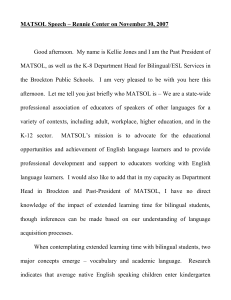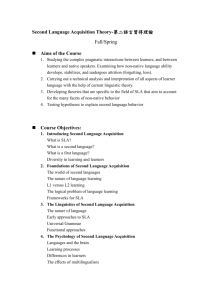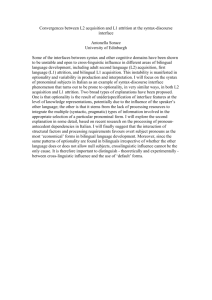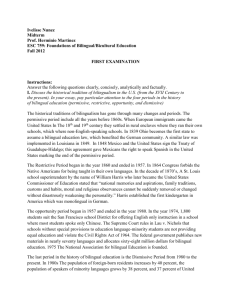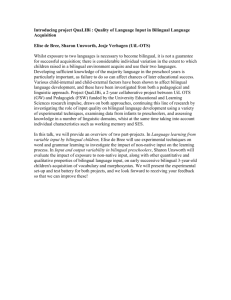Introduction to Part 1: Acquisition
advertisement
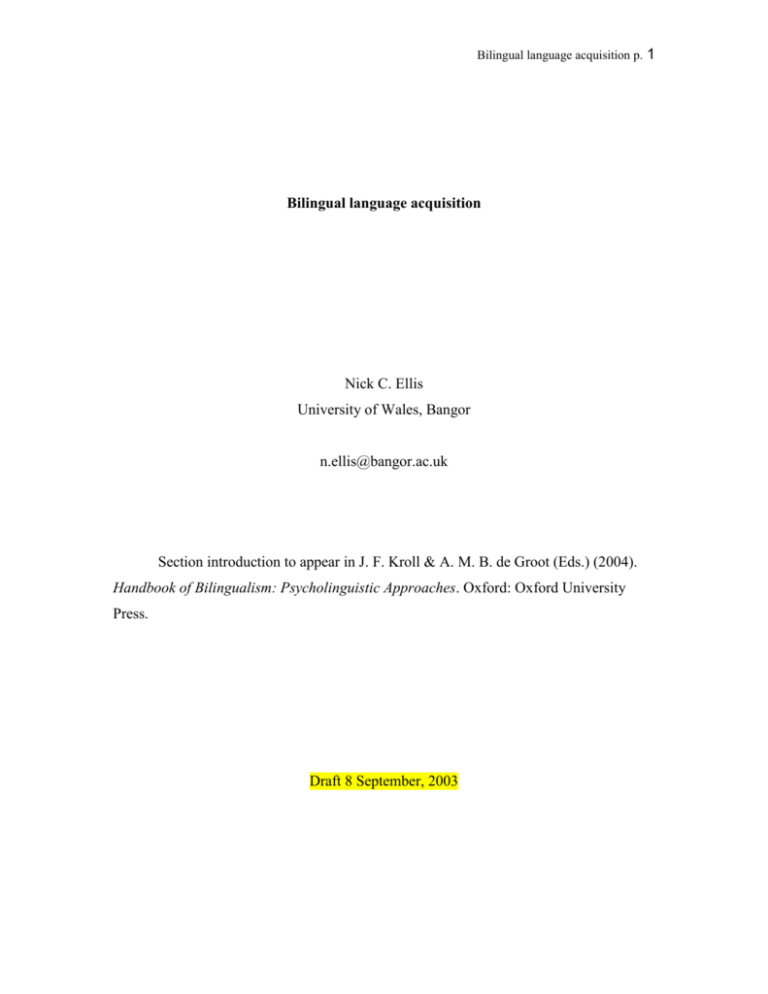
Bilingual language acquisition p. Bilingual language acquisition Nick C. Ellis University of Wales, Bangor n.ellis@bangor.ac.uk Section introduction to appear in J. F. Kroll & A. M. B. de Groot (Eds.) (2004). Handbook of Bilingualism: Psycholinguistic Approaches. Oxford: Oxford University Press. Draft 8 September, 2003 1 Bilingual language acquisition p. 2 Bilingual language acquisition How we acquire our native language is a question fundamental to humankind. It pervades the long history of our inquiries, yet it is an interesting and difficult enough issue to have escaped a consensual answer to date. Indeed, never has there been so much debate as there currently is concerning the mechanisms of first language (L1) acquisition. Simple arithmetic might suggest that the question of bilingual acquisition, then, would be doubly worthwhile. But the chapters that follow here belie this calculation, with the L2 = 2 x L1 sum falling far short of the real interest mark. Factors such as language transfer, typological distance and interaction, the much wider possible ranges of second language (L2) social environments, ages of acquisition, levels of learner cognitive and brain development, motivations, educational environments, and language exposure, in multiple factorial interactions, conspire to make bilingualism and second language acquisition (SLA) far more complex and fascinating than the mere sum of two L1A parts. And multilingualism is humankind’s norm. With perhaps 6000 languages of the world, far more than the 200 or so countries, an equally rough and ready calculation suggests that human beings are more likely than not to be able to speak more than one language. This section on Acquisition provides tutorials on what is currently known about how these diverse factors make SLA so rich and interesting. In what follows here I will briefly introduce these reviews and pull out some of the key themes, generalities and differences: some summary and sums. A number of the chapters cover areas that reflect traditional boundaries in linguistics: vocabulary, syntax, phonology, grammar and processing. Others review work done within an approach: the competition model, processability theory, or connectionism. Others still focus upon factors which moderate the degree to which SLA resembles L1A: age and transfer. As you read these chapters, bear ever in mind the scope for complexity in SLA and avoid over-ready generalizations. Despite their likenesses, the sum L1A = SLA is as much an oversimplification as is the assumption of identity even within bilingual acquisition itself: Acquiring two languages from birth (bilingual first language acquisition) is quite a different thing from acquiring a second language in later life, BFLA ≠ SLA. Moderating variables such as age have differential effects on the degrees to which L1A ≈ SLA in phonology, lexicon, syntax, morphology, and pragmatics. Effects which pertain in one representational domain need not apply in another, for example, transfer pervades phonology, but may be more circumscribed in intermediate and higher levels of syntactic generation. Vocabulary In chapter 2, De Groot and Van Hell consider the learning of foreign language vocabulary. The starting point of SLA is words and lexicalized phrases, and vocabulary acquisition continues as a constant throughout our experience of language: however proficient we are, most days provide us the experience of new words. The richness of learners’ vocabulary is a major determinant of both their communicative efficiency and Bilingual language acquisition p. 3 their understanding of their second language, and vocabulary breadth fuels the acquisition of other language representations too, with a sufficient mass of exemplars providing the database from which the regularities of phonology, morphology and syntax can be abstracted. De Groot and van Hell focus on direct methods of learning vocabulary, since a vocabulary of the 3000 most frequent word families provides around 95% of the coverage of written texts. They review keyword, rote-rehearsal, word-association, and picture association methods for learning foreign language vocabulary, and they evaluate their effects on receptive and productive learning, speed of access, and resistance to forgetting. Words vary on various dimensions such as their concreteness, their morphological, phonological and orthographic complexity, their frequency, and their cognate status, and all of these factors are shown to affect the ease of learning of a word and its eventual representation. Concrete words are easier to learn than abstract words, a result of their greater information content, richer representation, and greater opportunity for anchoring and retrieval. Word forms which are phonologically familiar to the learner are easier than those which sound more foreign. And these two factors compound in making cognate words particularly easy to learn. De Groot and van Hell analyze these effects in terms of their implications for the structure of the bilingual lexicon, i.e. whether it is compound, coordinate, or subordinate, an issue which is considered later in this volume as it applies to proficient bilingual representation. Whatever the structure of the bilingual lexicon at fluency where thousands of hours of contextualized L2 vocabulary use have ground direct connections between the L2 forms and their meanings, the evidence here suggests a ‘word association’ organization of the low proficiency learner where the processing of L2 is mediated via the L1. Early L2 vocabulary acquisition is parasitic upon L1 phonological representations, L1 conceptual representations, and L1 word-concept mappings, and L2-L1 independence only comes as a result of considerable L2 experience. Syntax In chapter 3, De Houwer focuses on early bilingual acquisition of morphosyntax. In acquiring two languages from birth with parents who accord to the ‘one person, one language’ principle, a situation referred to as Bilingual First Language Acquisition (BFLA), do children undergo a double acquisition process in which the two morphosyntactic systems are acquired in parallel as fundamentally independent closed systems (the ‘Separate Development Hypothesis’, SDH)? Alternatively, does BFLA produce a single hybrid, a 'Mish-Mash’ resultant from systematic morphosyntactic influence from each language on the other? Research in the 1970s had suggested the single system hypothesis to hold, with children systematically applying the same syntactic rules to both languages. De Houwer corrects this misapprehension. She begins with a clear methodological analysis of the types of evidence required to test the SDH, particularly that separate development must be evident for most of the comparable morphosyntactic structures in the child's speech that reflect differences in the input languages. She then reviews the majority of the longitudinal studies published in the last 15 years that have looked at morphosyntactic development in BFLA children. Her analysis of the speech productions of these 29 children between the ages of 1 and nearly 6 years, who together acquired 12 languages in 13 different combinations, showed that no Bilingual language acquisition p. 4 child produced the sort of language repertoire that would be predicted to develop in bilingual children in line with a transfer theory. Young bilingual children reflect the structural possibilities of both languages they have been exposed to, and are able to produce utterances that are clearly relatable to each of their different languages; from very early on, the morphosyntactic development of the one language does not have any fundamental effect on the morphosyntactic development of the other. In general, BFLA children's language-specific development within one language differs little from that of monolingual acquisition, except of course that bilingual children do it for two languages at a time. Equally, like adult bilinguals, young BFLA children are able to switch between languages very easily, either at utterance boundaries or within utterances. De Houwer also claims that there is no evidence that hearing two languages from birth leads to language delay. Empirical confirmation of the SDH entails that young bilingual children are keenly attuned to the specific linguistic environments they find themselves in. In chapter 4, MacWhinney considers SLA. In contrast to infant (B)FLA, L2 learners already know a great deal about the world, their brains are committed and entrenched in their L1, and they cannot rely on an intense system of social support from their caregivers. These differences have led some researchers to propose that SLA requires a totally separate understanding from L1A. Yet the many similarities of microprocess in first and second language acquisition, and the fact that L2 learning is influenced by transfer from L1, means that a model of SLA must take into account the acquisition and structure of L1. For these reasons MacWhinney sketches the plan of a new unified model in which the mechanisms of L1 learning are seen as a subset of the mechanisms of L2 learning. This unified account builds upon his earlier Competition Model which maintains that the learner’s task is to learn the forms of language which serve as the most reliable cues to interpretation: in essence, trying to learn the probability distribution P(interpretation|cue, context), a mapping from form to meaning conditioned by context, with the different interpretations competing for realization in any particular context according to their cue strength. All language processing can be viewed thus as a set of competitive interactions, driven by either auditory and formal cues in comprehension or functional cues in production. The unified model supports this theory of cue validity by extending it here with additional theoretical constructs for dealing with cue cost and cue support. Cue cost relates to the salience of formal cues, particularly the forms which are not salient to the learner because of their expectations that have developed from their first language experience: these are aspects of learned selective attention resulting from transfer. In order to properly acquire these low salience cues, L2 learners can support their implicit learning with additional cognitive mechanisms such as combinatorial learning, chunking, and use of analogy in the acquisition of new linguistic constructions, mnemonics and other metalinguistic knowledge, and the use of social support strategies. The unified model incorporates a grounded-cognition, functional explanation of grammar as a set of devices that mark the flow of perspective across five cognitive domains: direct perception, space-time deixis, causal action, social roles, and belief systems. In these ways MacWhinney links research in bilingualism to mainstream cognitive psychology and to cognitive and functional linguistics. And all of these areas predict that there will be considerable transfer in second language acquisition: connectionism predicts it, spreading activation predicts it, the notion of ‘thinking for speaking’ predicts it, and perceptual learning and interference theory predict it. Bilingual language acquisition p. 5 MacWhinney reviews the factors that promote, and those that protect against, language transfer in phonology, lexicon, syntax, morphology, and pragmatics. Phonology and Bilingualism In chapter 5, Sebastián-Gallés and Bosch consider bilingual acquisition of phonology. In the first year of life it is almost guaranteed that monolingual children will acquire the ability to process the sound system of their native language. Yet, when L2 learners later in life try to acquire these same abilities, most of them do not succeed; their speech is betrayed by their non-native accent, and in listening they often fail to correctly perceive foreign sounds. Sebastián-Gallés and Bosch consider L1A, BFLA, and adult SLA of the range of systems of phonological representation. At four and a half months of age, bilingual infants can separate their languages, recognizing when there is a switch from one to the other, even if they are rhythmically very similar. By six months old, monolingual infants show maternal language-specific phoneme perception behavior, and their sensitivity to non-native phonetic contrasts declines during the first year of life. Thus acquisition reflects processes of perceptual reorganization that result from linguistic experience, with monolingual children’s phonological system becoming perceptually tuned to optimally categorize their native language. For bilingual children the outcome of these perceptual reorganization processes should result in two sound systems corresponding to the two languages of their experience. It does, but their perceptual learning takes longer: it is only by 14-21 months of age that bilinguals show evidence of categorizing stimuli as do monolinguals in each of their two languages. If these discrimination capacities of BFLA children are temporarily delayed in comparison to monolinguals, this is nothing compared to the difficulties of second-language learners when processing non-native phonemes. Sebastián-Gallés and Bosch review theories of why is it so difficult to perceive some foreign contrasts and why these difficulties are not “universal”, but depend on the first language of the listener: the ease or difficulty with which two phonemes will be discriminated depends on the similarities and differences between L1 and L2 phoneme systems. They then ask these same questions for bilingual acquisition of the perception of stress, phonotactics, and receptive and productive lexicons. The lexical activation studies, additionally addressed later in this volume in chapters concerning adult bilingual comprehension, production, and control, persuasively demonstrate that, even when placed in a totally monolingual mode, phonological input activates both of the bilingual’s auditory lexicons. The acquisition and processing of phonology is riddled with transfer effects. Biological Bases The next two chapters provide a balanced perspective on issues relating to age and critical periods for SLA. It is an incontrovertible fact that ultimate second language attainment is less successful in older rather than younger learners. Both chapters agree on this. There is a large body of empirical evidence showing that age of acquisition is Bilingual language acquisition p. 6 strongly negatively correlated with ultimate second language proficiency, for grammar as well as for pronunciation. But close scrutiny of this effect reveals a range of different interpretations, the implications of which are currently being debated in the literature. In chapter 6, DeKeyser and Larson-Hall present a detailed review of the published results relating age-of-acquisition (AoA) and proficiency. These studies have tested speakers of a wide variety of languages using a wide variety of testing formats and dependent variables, albeit with grammaticality judgments as the most common measure of morphosyntax, and global pronunciation ratings the most common index of phonological proficiency. The large majority of these studies have demonstrated substantial child-adult differences or strong correlations between AoA and L2 proficiency. L2 learners’ performance in morphosyntax varies as a function of age more when grammaticality items are presented in oral than in written form, and not all areas of the target-language grammar are equally susceptible to age effects. Despite these variations, DeKeyser and Larson-Hall argue that the evidence is doubtful that any person has learned a second language perfectly in adulthood, claiming that four studies showing overlap between adult and native acquirers for morphosyntax can be explained to result from methodological factors and that the rare observation that some learners can achieve very high levels of native-like pronunciation are limited to performance on constrained rather than spontaneous production tasks. Their subsequent analysis considers whether the age effect may be due to confounded variables such as quantity and quality of input, amount of practice, level of motivation, and other social variables differentiating child and adult learners, but they discount the role of these confounds since these variables play a limited role when the effect of age of acquisition is removed statistically, while age of acquisition maintains a large and significant role when the social and environmental variables are removed. Despite their clear conclusion that there is a maturational decline in second language learning capacity during childhood, DeKeyser and Larson-Hall caution that it is important not to overinterpret the implications of this finding for educational practice. The observation that ‘earlier is better’ only applies to certain kinds of naturalistic learning, which schools typically cannot provide. The implication of this research for education is that instruction should be adapted to the age of the learner, not that learners should necessarily be taught at a young age. If early language teaching is needed, it should be based on communicative input and interaction, whereas adolescents and adults need additional focus on form to aid explicit learning mechanisms which at least some of them can substitute for implicit learning with a satisfactory degree of success. In chapter 7, Birdsong subjects many of these same studies relating age and SLA to an equally admirable methodological scrutiny. He cautions that there is a constant need to assess independently the effects of length of residence (and consequent amount of L2 exposure) and AoA. But his major critique concerns not the effect of age per se, but rather whether the reported relationships between AoA and attainment conform to a strict notion of a critical period. The orthodox conception of a critical period hypothesis (CPH) is that there is a circumscribed developmental period before adulthood during which SLA is essentially guaranteed, and after which mastery of an L2 is not attainable. Accordingly there should be discontinuities in the function relating age and ultimate attainment. In Bilingual language acquisition p. 7 particular, there should be an offset, coinciding with the point at which full neurocognitive maturation is reached, after which no further age effects are predicted. However, Birdsong’s analysis of end-state SLA research reveals little congruence with these geometric and temporal features of critical periods. The geometry of the age function (its slope and any discontinuities), as well as temporal features of the age function (the points at which AoA begins to, and ceases to, correlate significantly with outcomes) varies from study to study, depending on such factors as the linguistic feature being tested, amount of L2 use, and L1-L2 pairing, and the general conclusion is that there is no apparent period within which age effects are observed but rather that they persist indefinitely. Birdsong also reviews these studies with an aim to determining whether there are any cases of nativelike attainment in late bilinguals. He concludes that this is possible in rare but non-negligible frequencies, and that the 5% or greater incidence of nativelikeness in late bilinguals, which is roughly as predicted from the slope of the age function, is a substantial enough incidence to warrant rejection of a strong CPH for SLA. The Human Language Processor, Grammar, Transfer and Acquisition In chapter 8, Pienemann, Di Biase, Håkansson and Kawaguchi describe Processability Theory (PT), a psycholinguistic analysis of the human language processor and its operation according to linguistic analyses using Lexical-Functional Grammar, a unification grammar attractive in its typological and psychological plausibility. The basic logic underlying PT is that structural options are produced in the learner’s interlanguage only if the necessary processing procedures are available. Language acquisition routes are thus constrained by the architecture of the human language processor since, for linguistic hypotheses to transform into executable processing skills, the processor needs to have the capacity for processing the structures relating to those hypotheses. PT can be applied cross-linguistically to investigate the nature of the computational mechanisms involved in the processing and acquisition of different L1s. PT can also be used to analyze the interplay between L1 transfer and psycholinguistic constraints on L2 processability: it assumes that the initial state of the L2 does not necessarily equal the final state of the L1 because there is no guarantee that a given L1 structure is processable by the under-developed L2 parser. In other words, L1 transfer is constrained by the capacity of the language processor of the L2 learner irrespective of the typological distance between the two languages. Pienemann et al. present a cross-linguistic survey of L1 transfer effects in SLA and demonstrate (i) that learners of closely related languages do not necessarily transfer grammatical features at the initial state even if these features are contained in both L1 and L2, providing the features are located higher up the processability hierarchy, (ii) that such features are transferred when the interlanguage has developed the necessary processing prerequisites, and (iii) that typological distance and differences in grammatical marking need not constitute a barrier to learning if the feature to be learned is processable at the given point in time. These findings strongly qualify Bilingual language acquisition p. 8 theories that emphasize extensive L1 transfer at the initial state and they demonstrate the ways that processability moderate L1 transfer. Computational Simulation In chapter 9, Murre reviews computational models of monolingual and bilingual acquisition. As is abundantly clear from preceding chapters, the ways by which exposure to tens of hundreds of hours of language input results in the mental representation of language are hugely complex. There are too many variables to hold in mind for a properly considered complete theory. Therefore language researchers take recourse to computer modeling where the test of the simulation is whether competences emerge which parallel those of human language learners exposed to similar input. In this way, the debate between deductive and inductive approaches to language acquisition is being rephrased in terms of well-articulated models and real-world data. Murre reviews computational simulation research into language acquisition using subsymbolicinductive connectionist approaches. Such research demonstrates that despite being very noisy and inconsistent, the nature of language input is nevertheless sufficient to support inductive mechanisms whereby seemingly rule-like behavior emerges from a data-driven learning process. Examples are given from a variety of language domains (including stress assignment, phonology, past-tense formation, localization, and certain aspects of semantics), using a variety of exemplar-based and connectionist architectures (including feedforward networks, simple recurrent networks, Hopfield nets, and Kohonen selforganizing maps for monolingual perceptual and semantic representation and as a bilingual processing application SOMBIP), and a variety of theoretical frameworks (including Latent Semantic Analysis, the Competition model, the Interactive Activation Model and its bilingual extensions BIA and BIMOLA, and the bilingual Speech Learning Model). Different aspects of language are best modeled using different architectures, a finding that accords well with the individualities outlined at the beginning of this introduction. Murre concludes that, compared to the thriving field of computational psycholinguistics and the developing subfields of models of language acquisition or models of bilingual processing, there are still very few models of bilingual language acquisition and suggests a number of areas of bilingual acquisition ripe for simulation research. Summation As each of these chapters shows, we have come a long way in our understanding of these complex issues. But the most telling insight, which only becomes apparent from the compendium of a handbook like this, is what we see from the alignment and comparison of what is currently known about these issues when taken together. It is clear that a true understanding can only come from the synthesis of these different questions and approaches. Three themes stand out in my mind in illustration of this. The first is the age factor and how it engages aspects of interaction and contexts of acquisition, education, transfer, and brain. While DeKeyser and Larson-Hall and Birdsong might disagree over continuity/discontinuity in the AoA/SLA endstate function Bilingual language acquisition p. 9 and about the possibility of nativelike attainment in late bilinguals, they are in clear accord that SLA is less successful in older learners. There follows the question of why this should be, a single question which begs considerable further research. What are the brain mechanisms that underpin such loss of plasticity, are they a function of age or increasing L1 entrenchment? What is the role of linguistic variables in determining the timing and shape features of the age function? What are the cognitive developmental factors relating to these differences, particularly those relating to implicit and explicit learning potential in adults and children? What are the implications for the promotion of multilingualism? The second is second language processing (Pienemann et al.). We require a psycholinguistically plausible account of grammar, one whose processing stages are clearly specified, and one that can be applied to different languages in a principled way. We need a well-specified theory of the architecture of the human language processor. We need to understand how this processor develops and how new routines are acquired as a result of exposure to the linguistic evidence available from the input. We need to understand language typology and distance. We need to understand the interplay between language transfer and language-specific growth. The third is transfer itself. These chapters clearly demonstrate linguistic transfer, most reliably with regard the acquisition of L2 phonology (Sebastián-Gallés and Bosch; De Groot and Van Hell), but with examples spanning lexicon, orthography, syntax, and pragmatics. Hence MacWhinney’s general Competition Model dictum that “everything that can transfer will”. But there are situations which seem to protect against transfer too. BFLA seems to promote rapid language-specific morphosyntax acquisition to the standards expected of monolinguals, not some messy ‘Mish-Mash’. To what extent is it the FLA aspect of this equation which allows this success, or the clear environmental cuing which comes from ‘one person, one language’? Is the acquisition of two separate syntactic systems really as rapid as the acquisition of just one, and if so, why is this true for syntax (De Houwer), whereas the BFLA of phonology is somewhat delayed in comparison to monolingual acquisition (Sebastián-Gallés and Bosch). Pienemann et al. similarly provide evidence of lack of transfer in L2 sentence production. Is it the case that transfer has its effects via selective attention, the way learners perceive the L2 input, and the hypotheses they generate about the second language, whereas the processing of the L2 rapidly becomes L2-content driven, with the modularity of the eventual L2 grammar driven by the combinatorial possibilities of L2 lexical forms and constructions and unsullied by cross-linguistic influence? Modular systems are implicit, the sorts of system which are well simulated by connectionist models (Murre). They are automatic in their inhibition of cross-linguistic competitors. How is this selective interference of a multilingual’s other languages controlled? Consciousness unites, with the potential to pull together everything we know. To what extent is transfer an implicit learning phenomenon and to what extent is it determined by explicit learning under attentional control? What are the cues that multilingual individuals use to determine which language is being spoken, how these are mentally represented, and how do they function in language processing? We have to know all of these things. The beginnings of answers to some of these questions are to be found elsewhere in this handbook. But in sum, only some. The further concerted efforts of cognitive neuroscience, linguistics, psychology and education are Bilingual language acquisition p. 10 required to fully appreciate the complex nature of bilingualism. It has been claimed that binary variables have properties of all other scales: in a paradoxical way, the two values meet requirements of nominal, ordinal, interval and ratio scales. The evidence of this section shows that it less of a stretch to claim that bilingual language acquisition has properties of first language acquisition, and much much more besides.
